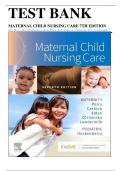TEST BANK
MATERNAL CHILD NURSING CARE 7TH EDITION
S.E. Perry, M.J. Hockenberry, K. Cashion, K.R. Alden, E. Olshansky, D.L. Lowdermilk
,Chapter 01: 21st Century Maternity Nursing....................................................................................................................... 4
Chapter 02: The Family, Culture, and Home Care .......................................................................................................... 13
Chapter 03: Assessment and Health Promotion .............................................................................................................. 19
Chapter 04: Reproductive System Concerns ................................................................................................................... 30
Chapter 05: Infertility, Contraception, and Abortion .......................................................................................................47
Chapter 06: Genetics, Conception, and Fetal
Development........... 59
Chapter 07: Anatomy and Physiology of Pregnancy ...................................................................................................... 70
Chapter 08: Nursing Care of the Family During Pregnancy ........................................................................................... 81
Chapter 09: Maternal and Fetal Nutrition ................................................................................................................... 93
Chapter 10: Assessment of High-Risk Pregnancy ...................................................................................................... 104
Chapter 11: High-Risk Perinatal Care: Preexisting Conditions .................................................................................. 113
Chapter 12: High-Risk Perinatal Care: Gestational Conditions .................................................................................. 125
Chapter 13: Labor and Birth Processes........................................................................................................................ 143
Chapter 14: Maximizing Comfort for the Laboring Woman ....................................................................................... 153
Chapter 15: Fetal Assessment During Labor ............................................................................................................... 164
Chapter 16: Nursing Care of the Family During Labor and Birth ............................................................................... 176
Chapter 17: Labor and Birth Complications ............................................................................................................... 191
Chapter 18: Postpartum Physiologic Changes ............................................................................................................ 202
Chapter 19: Nursing Care of the Family During the Postpartum Period .................................................................... 212
Chapter 20: Transition to Parenthood ......................................................................................................................... 220
Chapter 21: Postpartum Complications ...................................................................................................................... 230
Chapter 22: Physiologic and Behavioral Adaptations of the Newborn ...................................................................... 240
Chapter 23: Nursing Care of the Newborn and Family .............................................................................................. 253
Chapter 24: Newborn Nutrition and Feeding .............................................................................................................. 261
Chapter 25: The High-Risk Newborn .......................................................................................................................... 272
,Chapter 26: 21st Century Pediatric Nursing ................................................................................................................ 289
Chapter 27: Social, Cultural, Religious and Family Influences on Child Health Promotion ..................................... 294
Chapter 28: Developmental and Genetic Influences on Child Health Promotion ....................................................... 298
Chapter 29: Communication and Physical Assessment of the Child and Family ........................................................ 310
Chapter 30: Pain Assessment and Management in Children ....................................................................................... 325
Chapter 31: The Infant and Family .............................................................................................................................. 331
Chapter 32: The Toddler and Family ........................................................................................................................... 345
Chapter 33: The Preschooler and Family .................................................................................................................... 357
Chapter 34: The School-Age Child and Family .......................................................................................................... 365
Chapter 35: Health Promotion of the Adolescent and Family ......................................................................................379
Chapter 36: Impact of Chronic Illness, Disability, or End-of-Life Care on the Child and Family .............................. 392
Chapter 37: Impact of Cognitive or Sensory Impairment on the Child and Family .................................................... 405
Chapter 38: Family-Centered Care of the Child During Illness and Hospitalization .................................................. 418
Chapter 39: Pediatric Nursing Interventions and Skills ............................................................................................... 429
Chapter 40: The Child With Respiratory Dysfunction ................................................................................................ 444
Chapter 41: The Child With Gastrointestinal Dysfunction ......................................................................................... 458
Chapter 42: The Child With Cardiovascular Dysfunction ........................................................................................... 471
Chapter 43: The Child With Hematologic or Immunologic Dysfunction ................................................................... 491
Chapter 44: The Child With Cancer ............................................................................................................................ 502
Chapter 45: The Child With Genitourinary Dysfunction ............................................................................................ 509
Chapter 46: The Child With Cerebral Dysfunction ..................................................................................................... 521
Chapter 47: The Child With Endocrine Dysfunction .................................................................................................. 535
Chapter 48: The Child With Musculoskeletal or Articular Dysfunction.....................................................................547
Chapter 49: The Child With Neuromuscular or Muscular Dysfunction ..................................................................... 558
Chapter 50: The Child With Integumentary Dysfunction ........................................................................................... 566
, Chapter 01: 21st Century Maternity Nursing
Perry: Maternal Child Nursing Care, 7th Edition
MULTIPLE CHOICE
1. When providing care for a pregnant woman, the nurse should be aware that one of the most
frequently reported maternal medical risk factors is a. diabetes mellitus.
b. mitral valve prolapse (MVP).
c. chronic hypertension.
d. anemia.
ANSWER: A
The most frequently reported maternal medical risk factors are diabetes and hypertension
associated with pregnancy. Both of these conditions are associated with maternal obesity.
There are no studies that indicate MVP is among the most frequently reported maternal risk
factors. Hypertension associated with pregnancy, not chronic hypertension, is one of the most
frequently reported maternal medical risk factors. Although anemia is a concern in pregnancy,
it is not one of the most frequently reported maternal medical risk factors in pregnancy.
DIFFICULTY: Cognitive Level: Knowledge OBJECTIVE: Nursing Process: Assessment
MED SC: Client Needs: Physiologic Integrity
2. To ensure optimal outcomes for the patient, the contemporary maternity nurse must
incorporate both teamwork and communication with clinicians into care delivery. The SBAR
technique of communication is an easy-to-remember mechanism for communication. Which
of the following correctly defines this acronym? a. Situation, baseline assessment, response
b. Situation, background, assessment, recommendation
c. Subjective background, assessment, recommendation
d. Situation, background, anticipated recommendation
ANSWER: B
The situation, background, assessment, recommendation (SBAR) technique provides a
specific framework for communication among health care providers. Failure to communicate
is one of the major reasons for errors in health care. The SBAR technique has the potential to
serve as a means to reduce errors.
DIFFICULTY: Cognitive Level: Comprehension
OBJECTIVE: Nursing Process: Assessment | Nursing Process: Planning
MED SC: Client Needs: Safe and Effective Care Environment
3. The role of the professional nurse caring for childbearing families has evolved to emphasize
a. providing care to patients directly at the bedside.
b. primarily hospital care of maternity patients.
c. practice using an evidence-based approach.
d. planning patient care to cover longer hospital stays.
ANSWER: C
Professional nurses are part of the team of health care providers who collaboratively care for
patients throughout the childbearing cycle. Providing care to patients directly at the bedside is
one of the nurse‘s tasks; however, it does not encompass the concept of the evolved
professional nurse. Throughout the prenatal period, nurses care for women in clinics and
physician‘s offices and teach classes to help families prepare for childbirth. Nurses also care




